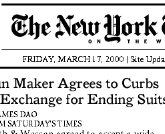COMPANIES may spend millions on their identities and brands
offline, but when it comes to the web site, some odd transformation
happens. They begin to look different. The same values that
made them strong in the physical world don�t get transferred
to the virtual one.
Part of the problem is managing identities
online. Some companies have had to contract their web management
to others who may not have had a part to play in the development
of the offline identity. They may not be as intimately involved
and make no steps to correct that. Therefore, the web site looks
like an afterthought�because it is.
A related problem is that the web site was
not part of the identity planning�this once existed at Unilever�s
site with numerous broken links (October 1996). The newer breed
of designers recognizes that designing for the web has different
rules, some of which mirror television practice (the lower resolution
making serifs unfavourable for one) and some of which are unique
to the medium (the changing of browser sizes forcing any set
design to change).
A second part is that some companies perceive
the online world to be different from the offline one. That�s
true to some extent: on the web, the leading player may be unknown
in the "real" world. Therefore, different design considerations
come into play because the competitive focus changes. Companies
such as Chrysler and
Disney have had to do this
in recent years before consistent branding strategies encompassing
the web emerged.
Third, the problem may be cultural. The web
has simply not been a part of the organization. It is playing
catch-up, now that it realizes that a web address is as fundamental
as a fax number. But its business practices are still firmly
placed in the offline world and it fails to capitalize on the
potential growth offered by a web presence. Thus, any web site
again looks like an afterthought, often with broken links and,
usually, poor design. The legal sector, usually outside the
US, is often guilty of this.
The ideal is to have another few thousand
to a few million spent on redoing an identity to encompass the
web, to introduce a cultural shift, and to realign the strategy
to include the online world.
Usually this is going to cost the higher amount.
Companies may suddenly decide that the only way to survive is
to go online: Encyclopædia
Britannica found its sales hurt by Microsoft�s Encarta and
had to shift its focus from the traditional, printed encyclopædias
to digital ones, cannibalizing its core business. An identity
change was imposed. If Britannica had a choice, it would have
entered the digital world when it felt ready.
The ideal of revamping an identity�and this
means the inclusion of its business philosophy, principles and
strategy�isn�t going to be available to every type of firm.
So, what can be done?
IN OUR first case, we have an organization that has spent a
great deal on its offline identity and brand. It did this in,
say, 1990. By 1996 its rivals had entered, so in 1997 it began
playing catch-up. It introduced its web presence�essentially
a "brochureware" site with some basic "catalogue"
or prospective material. Its traditional designers and printers
didn�t have a web presence, either, so the web design and management
were left over to a separate firm altogether. This web specialist
created a fanciful new design that had some basic relationship
to the original 1990 brand but was otherwise distinctive. By
1999 the two-year-old site had developed along its own path
and the organization has come to realize this. Still without
the money for a full identity revamp, what can it do to bring
it all together?
This is a common case, with only the years
differing. The first step is to find a web design company that
is more in tune with strategy. In 1997, there wasn�t much difference
to the everyday observer between a good web designer and a bad
web designer. In many cases, the web designer was found through
contacts and could not claim any former work to his or her credit.
Or the web designer was a graphic designer who was properly
trained�that helps greatly�but didn�t fully understand the implications
of the medium, such as linking, keywords and search-engine optimization.
Or the web designer understood these things but did not realize
that the best web sites have to go above and beyond brochureware.
What must it have to add value?
The key is communication. The company is now
in a better position in 2000 to fix the problems. Proper web
designers are available and have come to understand the issues
more. However, there are still many who do not understand identity.
The web design team should be introduced to
the organization. This could be done through meetings (online
or offline), expressing what makes it different. A competitive
analysis could be presented, covering both online and offline
sectors. The branding specifications should be made available.
And the web design team should be given some indication of the
company�s strategy. An organization that is long-term-focused
does not really expect its site to change drastically: just
enough to keep visitors coming but not so much as to suggest
changes in the identity and raison d�être.
Competent web designers should be able to
work around this without much difficulty. Good examples of infrequent
changes but high visitor numbers are frequently in the publishing
arena. They include FHM,
the British "lad" magazine. There have been two predominant
looks to the site in the last few years, promoted properly in
its offline media and conveying the same message through typeface,
colour and, of course, scantily clad women. The
New York Times� current site capitalizes on the traditions
of the printed newspaper, which must always remain its flagship
given its business focus, while ably competing with The
Washington Post and the Los
Angeles Times for a slice of the online newspaper market.
Colgate-Palmolive is a
good example of extending the organization�s philosophy on to
the web. Poor examples might include Miramax
Café, where the studio vision and the grunge-inspired
site�s style do not seem to meet.
THE second case is a little more difficult. A site looks different
from the offline brand because of competitive moves. It finds
it has to compete with different firms online than offline and
its design has to change to compete with that.
The first method is where the organization
does some soul-searching and decide where its focus is and through
which medium audiences will come into contact with it the most.
Or where its principal revenue stream will be. Usually, this
means that the more visible medium should be the driver. However,
this also demands that the organization go through a cultural
shift, especially if the more visible medium happens to be the
web and its identity was planned for an offline audience. In
short, this is expensive.
CAP
began offline but we shifted our emphasis to the site. The print
magazine, now CAP Print, became the secondary publication
soon after we realized we were reaching more people on the web.
It�s easier, however, when you�re a small firm and decisions
can be made quickly. It�s even easier when the people who work
there understand the balance between online and offline, and
the identity and branding profession. Organizations with strong
marketing orientations (some gasoline retailers spring to mind)
may be able to pull this off with ease.
The second method is to realign everything
to the original vision, assuming it was well conceived and for
the long term. A talented and professional web designer should
be able to translate an offline identity�s principles. They
can still be apparent even when the competitors change, so the
organization can capitalize on its multi-media (as opposed to
multimedia) contact with audiences. An excellent example is
Newsweek, which has
enough of the elements of the print magazine and yet its functionality
allows it to go head-to-head with online news sites. The
Electronic Telegraph, although too different from The
Daily Telegraph and The Sunday Telegraph on its launch
in 1994, has since been redesigned to reflect more of the branding
seen in the printed newspapers and the weekly expatriate tabloid,
The Weekly Telegraph. After an earlier ill-conceived
site, Unilever now has
its web presence aligned with its principal identity, in an
attractive and cohesive site.
THE third case is the toughest. A firm playing catch-up and
requiring a cultural change to do it. It�s close to miracle-performing
but it can be done.
The legal sector is one of the trickiest.
Its work is going to be regional in most cases yet even in that
region there are competitors, some of which may have gone to
the web in some way. It is backed up with law journals and reviews,
commonly available in print, and by databases such as LEXIS-NEXIS.
It realizes it has to be present onthe web because its clients
may be wired and will find them online. Meanwhile, some practices
are going nationwide or international. Intellectual property
specialists are probably best to cross borders using the web,
but equally, so are private international law and administrative
law firms.
It�s no surprise that many law firms now have
marketing departments and specialists. The drive, however, has
to come from the principal partners.
First, some of the moves outlined for the
earlier scenarios could be used. But most of all, the organization
has to ask itself whether the web is a critical part of its
vision. Will it survive without the web? Perhaps more importantly,
will it still maintain its industry position without it? In
some rare cases the answers are �No,� and �Yes,� but we believe
that most organizations will answer �No,� to the second question.
It then has to discover how the web will play
a part in the organization. It may mean a complete revamp of
its business practices. It may mean staff changes. If it�s limited
funds-wise, its change could be confined to the marketing or
press relations� department�but at the same time, that department
must have interdepartmental support to implement change across
every part of the organization.
There is the potential for huge change that
will affect every aspect of the way the firm works. In other
words, there is no easy solution which designers can fix. The
shift has to be organization-wide for it to be truly successful
and if it is not a full identity revamp, then it should be something
driven by the marketing function and be integrated over time
so that the web component does not look like an add-on.
Some law firms are recognizing the need to
market themselves to a global audience and using the web to
do so, making use of press release services. Their names, sadly,
are not memorable, but they are making strong efforts to incorporate
the web into their strategy or simply their marketing mix. But
the changes have generally been organization-wide. A successful
antipodean example has been the IP firm of Baldwin
Shelston Waters, which has ensured consistency in all its
media. The 104-year firm has adopted well to the web and the
reality of marketing for legal services over the last few years.
All its typography is professional and consistent in all its
publications, tying in with its marketing plan. Insurance brokerage
Willis has a new
brand to extend its services and find customers through the
World Wide Web.
EVERY method outlined will require investment, and the department
selected for the job must be given an appropriate power base.
Identity is a valuable management resource and so the web must
fall within its scope.
Online, it�s not only firms such as Yahoo!
that have found growth. Everyday firms with a previously offline
existence, including our sister company, JY&A
Fonts, have discovered the web and found new markets and
sources of revenue�but they have only succeeded because they
have given the medium their full attention. It is never too
late to go online. The learning curve is steeper than it has
ever been, but happily the number of specialists is greater
and it has become easier to tell the good from the bad thanks
to emerging track records of success on the web. Jack Yan
Jack Yan is editor of CAP.
 The New York Times The web site reflects
the values of the flagship print product through typography
The New York Times The web site reflects
the values of the flagship print product through typography FHM also takes its print culture on to the web, with
two principal looks in the 1990s
FHM also takes its print culture on to the web, with
two principal looks in the 1990s Willis Corroon,
perhaps best known for being the offices which formed the backdrop
to the opening sequence to The Professionals, has revamped
its branding scheme to take advantage of the web
Willis Corroon,
perhaps best known for being the offices which formed the backdrop
to the opening sequence to The Professionals, has revamped
its branding scheme to take advantage of the web


